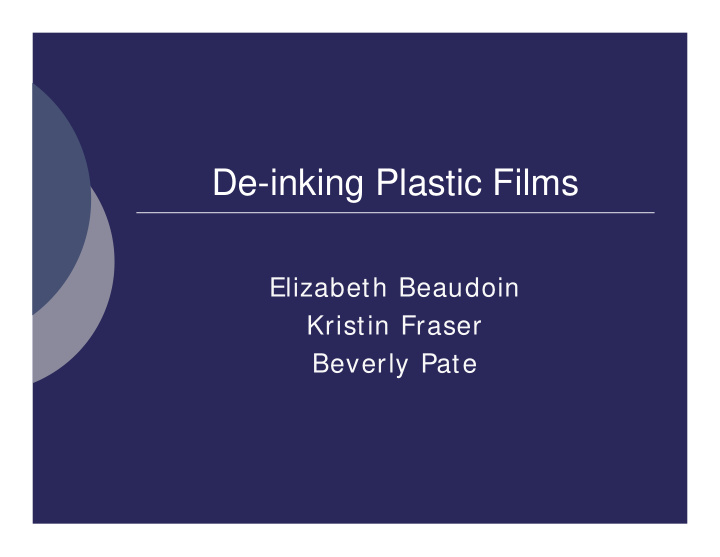



De-inking Plastic Films Elizabeth Beaudoin Kristin Fraser Beverly Pate
Problem Statement � Develop de-inking process considering � Type of plastic film � Collection strategies � Cost of production
What is De-Inking? � De-inking - removes ink, dyes, and other contaminates from a given material
Why De-Ink? � Growth of demand in plastics leads to an increase in plastic waste � Poor physical and mechanical properties due to residual ink
Why De-Ink? � Removing ink increases quality � De-inked plastic has a higher selling value
Problems with Recycled Plastic � Strength and elongation at break are decreased � Gases formed in extruded polymer � Color from residual ink
Project Milestones Understand mechanism 1. Separation techniques 2. Recovery issues 3. Marketability 4. Plant location optimization 5. Profitability 6.
To Understand Ink Attachment Composition 1. Surface tension 2. pH 3.
What is Ink Composed of? Pigments 1. Binders 2. Carriers 3. Additives 4.
Surface Tension � Caused by cohesion forces � Broken when cohesive forces are overcome by a stronger force � Surfactants create this atmosphere
Corona Discharge
pH � Causes the binder to agglomerate or extend � Isoelectric point - pH at which the number of anions and cations are equal
Ink Detachment Deprotonation 1. Surface adsorption 2. Ink detachment 3. Solubilization and stabilization 4.
Deprotonization HDPE
HDPE Surface adsorption
Raw Materials � Plastic � Why pick Wal-Mart bags? � Water-based ink � Made of HDPE � Wal-Mart donates used bags
Raw Materials � Base � Isoelectric point - pH of a solution at which the net charge of a molecule is zero � 3.1 for carboxylic acid � A pH of 12 is used
Raw Materials � Deionized water � Eliminates ions that could react with the deprotonated carboxylic acid groups
Raw Materials Surfactant - linear molecule that � modifies surface tension Four types of surfactant: � Cationic 1. Anionic 2. Amphoteric 3. Nonionic 4.
Raw Materials Surfactant continued � To increase de-inking efficiency � Longer alkyl chain length 1. Higher surfactant concentration 2. Hexadecyltrim ethylam m onium � brom ide
Raw Materials
• Density separator o Hydrocyclone Solution Cleaning
Modified Hydrocyclone � The heavy stream exit flow can get clogged � Accumulation chamber resolves this problem
Considered Agitation Techniques Multiple CSTs with net separation 1. Batch industrial washing machine 2.
Separating Techniques Froth Floatation 1. Anionic Exchange Chromatography 2. Centrifuge 3.
Marketability � HDPE usage increases annually � There is a larger demand for recycled plastic than can be met � Nonrenewable natural resources used to make plastic are being depleted � The economic feasibility of de-inking HDPE will likely increase in the future
Market Size � Amount of plastic possibly recovered in 2006 is 96 thousand tons � 45% of plastic is film � 70% of plastic film is HDPE � Assume 15% recovery � Bags recovered ~ 5 ,0 0 0 tons/ year
Plastic Recovered vs. Year 1600 1400 Plastic Recovered (thousands of ton y = 91.951x - 182555 R 2 = 0.9758 1200 1000 800 600 400 200 0 1990 1992 1994 1996 1998 2000 2002 Year
Plant Location � Location Model created in GAMS � Optimize profit by minimizing transportation costs � Determine optimal location � Infeasible solution
Plant Location Plant location determined using � excel simulations 1. Calculated distances 2. Calculated bags available 3. Compared revenue and transportation costs Transportation cost = distance * cost of – traveling
Plant Location Determined profitability 4. Calculated total transportation cost 5. Compared NPW of possible plant 6. locations
Plant Location � 3 possible plant locations � New Rochelle, NY � Greenwich, CT � Englewood, NJ � Optimal Plant location: � Englew ood, NJ
Equipment Costs Equipm ent Price Total Quantity W asher/ Dryer $ 2 3 6 ,0 0 0 $ 2 3 6 ,0 2 1 1 $ 2 2 ,0 0 0 Soaker $ 5 ,4 3 9 4 $ 1 3 9 ,0 0 0 Hydrocyclone $ 1 3 8 ,8 8 6 1 $ 4 8 9 ,0 0 0 Extruder $ 4 8 8 ,9 0 9 1 $ 9 3 ,0 0 0 Pelletizer $ 9 2 ,9 1 7 1 $ 4 ,9 6 0 Recycle Tank $ 4 ,9 5 8 1 $ 4 ,3 0 0 Slicer $ 4 ,3 0 5 1 Storage Tank $ 1 3 ,2 5 7 1 $ 1 3 ,0 0 0 Pum p $ 1 ,7 5 0 1 $ 1 ,7 5 0 Trucks $ 1 0 0 ,0 0 0 1 $ 1 0 0 ,0 0 0 Total $ 1 ,1 0 2 ,7 5 8
Profitability Fixed Capital $ 7 ,1 7 0 ,0 6 0 I nvestm ent W orking Capital $ 1 ,2 6 5 ,3 1 0 Total Capital $ 8 ,4 3 5 ,4 0 0 I nvestm ent Total Product Cost $ 6 ,1 9 3 ,9 1 7
Profitability Pay-Out Tim e, POT 4 .2 9 8 5 Return on I nvestm ent, 1 6 .0 3 % ROI $ 1 ,7 5 0 ,8 Net Present W orth 2 6
Recommendations � Consider expansions and multiple plant locations � Extend project life � Consider de-inking other forms of HDPE
Questions?
Main Polymers Used in Plastic Film The branches prevent the nonlinear molecules from packing as closely as the linear, reducing their density
LDPE vs. HDPE � HDPE is made by Ziegler-Natta vinyl polymerization � Uses a transition metal to initiate polymerization � LDPE is made by free-radical polymerization � Uses an initiator molecule that breaks into free radicals. The unpaired electrons attack ethylene’s C= C forming new radicals
Recommend
More recommend